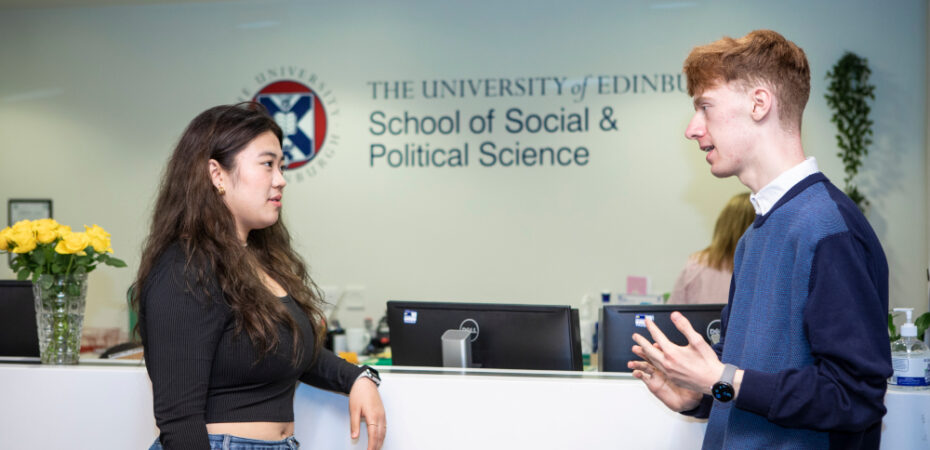
This post is a collaborative reflection by James Andrew (outgoing School of Social and Political Science Undergraduate Representative) and Catriona Elder (Head of Student Support and Experience) which contemplates how Student Councils can genuinely transform systemic issues at University. This post is part of the Student Voice in Practice series.
Breaking the silence: A shared vision
James: As the outgoing Undergraduate Representative at the School of Social and Political Science (SPS), I witnessed firsthand how traditional student representation often falls short. Student-Staff Liaison Committees (SSLCs) typically address immediate concerns but rarely tackle systemic issues. Students frequently feel disconnected from university decision-making processes, creating a representation gap that undermines the student experience.
Catriona: From the staff perspective, we were equally aware of these limitations. While dedicated to supporting students, we often found ourselves handling disconnected feedback without a coherent framework to address broader systemic issues. When James approached us about creating a more structured approach to student representation, we jumped at the chance of working in partnership towards transformative change.
The SPS Undergraduate Student Council model: A collaborative approach
Together, we developed a framework that brings together:
- Two programme representatives from each subject (one pre-honours and one honours)
- Widening Participation Champions
- The Undergraduate School Representative
James: What makes this model transformative isn’t just its composition but its methodical approach to creating change. The council identifies issues, breaks into focused taskforces, develops solution papers, seeks staff feedback, refines proposals, and presents them to relevant School committees.
Catriona: From our side, we worked with School leadership and committee chairs to raise awareness of the crucial role played by student reps on our decision-making bodies and create further opportunities for student participation e.g. on working groups. In terms of logistics, we helped secure meeting spaces, provided refreshments for meetings, and ensured representatives had access to necessary resources, meaning student representatives could focus on substantive issues.
Three pillars of transformation: What we have learned
1. Meaningful Student Voice
James: The council has created a mechanism that genuinely amplifies student concerns. Programme representatives now have a platform to escalate systemic issues beyond SSLCs, while as School rep, I had the apparatus to enact my manifesto promises.
Catriona: Staff have benefited enormously from this structured input. Proposals from the student council have been strategic and well considered, and the student voice much strengthened as a result, in particular on School committees We are now working in genuine partnership to co-create the student experience and shape meaningful change
2. Improved engagement and empathy
James: Perhaps surprisingly, the council has fostered greater understanding between students and staff. We make more informed critiques of university systems when given the space to have processes explained to us.
Catriona: This increased understanding works both ways. Staff gain clearer insights into the student experience, while students develop appreciation for the complexities of institutional processes. This mutual empathy has been a rewarding and very productive outcome of the council.
3. Institutional memory
James: Another valuable outcome has been creating continuity beyond individual representatives. The council creates an institutional memory that persists when representatives change.
Catriona: From a staff perspective, this continuity is vital. Rather than starting from scratch each year with new student representatives, we can build on previous work and maintain momentum on longer-term initiatives.
Implementation: Lessons from both sides
James: Creating the Council required School leadership support, which was absolutely crucial. Throughout the year, senior leadership provided encouragement and saw the transformative potential of this approach.
Catriona: Support from School leadership was indeed essential, but equally important was having dedicated student representatives willing to invest time in developing thoughtful proposals for enhancement and change. The success of this model depends on genuine commitment from both staff and students.
Scaling the revolution: Next steps
James: The success of the SPS model suggests several opportunities for expansion, including university-wide implementation and creating a Vice President Education Student Council.
Catriona: From an administrative perspective, implementing similar councils across Schools or Deaneries would require commitment to providing the necessary support structures, which is likely to look different depending on the make-up of the School/Deanery. However, the benefits in terms of student satisfaction and more effective governance make this investment – mostly in time and effort rather than financial cost – incredibly worthwhile.
Practical considerations for implementation
James: For Schools or Deaneries considering this model, representative training is essential in areas like chairing meetings and writing agendas.
Catriona: Planning is crucial. I recommend scheduling council meetings as soon as committee dates are released and recruiting representatives before the academic year begins. Early allocation of administrative support resources also helps ensure smooth operations.
Join the Student Voice revolution!
James: This isn’t just a new administrative model; it’s the beginning of a student voice revolution. We’re reimagining what student representation means and creating pathways for genuine change. Every area of the university has the opportunity to transform how student voices are heard and acted upon.
Catriona: The revolution needs both students and staff to succeed. For staff members reading this, I encourage you to reflect on these structures within your School; your support is essential. For students, consider how you might help establish or participate in a council at your School – and don’t be afraid to approach key staff members to ask their thoughts too
James & Catriona: Together, we’ve seen the transformative potential of this approach. Reimagining student representation isn’t just possible; it’s happening right now at the University of Edinburgh.
Will you join the revolution?
The future of meaningful student voice at our University depends on more champions embracing this collaborative model and taking it forward. We have the opportunity to lead the way in reimagining student representation. The question is not whether we can afford to implement such models across the university, but whether we can afford not to.
James Andrew is outgoing SPS Undergraduate Representative (2025) and Second-Year PPE Student.
Catriona Elder is Head of Student Support and Experience, in the School of Social and Political Science


